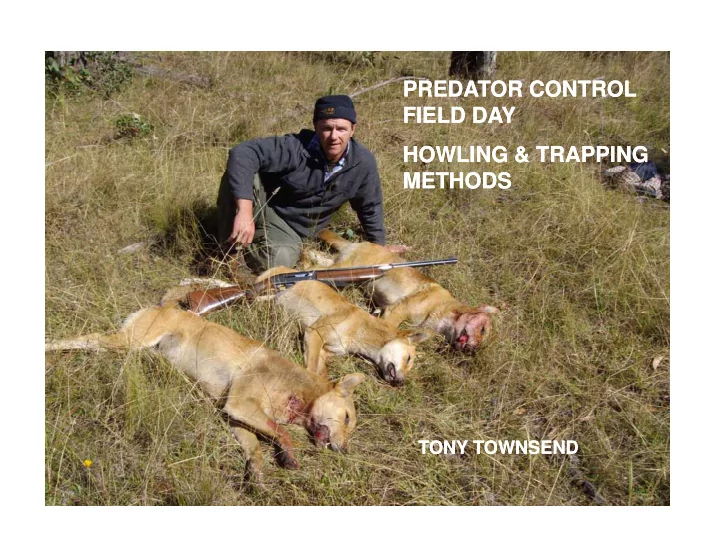

PREDATOR CONTROL PREDATOR CONTROL FIELD DAY FIELD DAY HOWLING & TRAPPING HOWLING & TRAPPING METHODS METHODS METHODS METHODS TONY TOWNSEND TONY TOWNSEND TONY TOWNSEND TONY TOWNSEND
Wild Dog Ecology and Behaviour Wild Dogs Include : Dingoes and their Hybrids Di d th i H b id Domestic Dogs living in a wild state
Pack Structure of Wild Dogs Wild Dogs generally form a Pack Structure Wild Dogs generally form a Pack Structure This structure will often include o Mated pair of adult dogs o Non-breeding offspring from the previous year o Pups from the current year P f th t Social ranking starting with Alpha Dogs Alpha Male and Female are responsible for teaching o Social ranking within the pack structure o Social ranking within the pack structure o Hunting techniques o Communication o Territorial zones
Breeding Patterns of Wild Dogs Starts usually between April to May Due to Hybridization the breeding cycles A Are changing to anytime within the year h i t ti ithi th Breeding typically once a year ( unable to sustain 2 litters of pups a year in the wild ) Usually only the Alpha Dogs ( stable pack ) Younger dogs are suppressed from breeding By Alpha dogs By Alpha dogs Gestation is approximately 63 days Litter sizes can range from 3 to 6 pups per year o Food supply is abundant o Hybridization Young dogs disperse at 8-24 months of age Young dogs disperse at 8 24 months of age
Den Sites and Communication Water is Vital W t i Vit l Den Sites are usually within 1 km of water Den Sites may include Den Sites may include o A hollow log o A hole in the side of a bank o A hole dug under rubbish or lantana Wild Dogs Communicate using a repertoire of o Olfactory ( smell ) o Tactile ( touch ) o Vocal and Visual Stimuli Wild Dogs scent mark using Urine and Scats along territorial boundaries Vocalization ( Howling ) announces Vocalization ( Howling ) announces o Territorial occupancy o Dog location and reunion
Basic Trap Sets Scent Post Set Canines select prominent objects to urinate on marking territorial boundaries marking territorial boundaries The Post Set is one of the oldest and most popular sets used in dog trapping . The set utilizes a small t d i d t i Th t tili ll stick or post with urine added to give the impression a canine has marked this post previously Natural urine posts can be found, but you can also create your own create your own
Trail or Walk Through Set The Trail-Walk through set is made directly in the path or trail used by the canine. Normally trail sets use no t il d b th i N ll t il t visual or scent attractants, They are simply set to ambush the canine as it travels along the path or trail. g p These types of sets are sometimes know as sneak These types of sets are sometimes know as sneak traps
Flat Set Flat sets are similar to Post sets in that they Fl t t i il t P t t i th t th employ a visual attraction in combination with a scent attractor to guide the animal to the set Sets should be in a prominent location and be Sets should be in a prominent location and be visually stimulating ( burnt log or old white bones )
Basics of Trap Setting p g Things to consider Before setting your trap o Location Location o Backing o Trap spacing and Bedding p p g g o Fastening or Drag Trap Location o Travel ways o Travel ways o Territories and boundaries o Special interest Locations
Travel Ways Travel Ways are the pads use by Wild Dogs to move around their territories o Generally the easiest route o Generally the easiest route o Allows for opportunistic hunting These Travel Ways may include o Cattle and other wildlife pads p o Walking or Vehicle tracks o Water courses ( dry river beds , gullies and drainage ditches ) o Fence lines F li
Special Interest Locations Travel ways leading to and from special interest features such as o Dead livestock o Dead native animals Dead native animals o Livestock dumps o Tips o Areas of high prey concentration ( rabbit warrens, stock yards etc )
Territories A Wild dogs territory is it’s living area or home range Size from 25 sq km upwards depending on food availability Bound by natural or man made geographical features o Mountain ranges M t i o Rivers or creeks o Animal or vehicle tracks o Animal or vehicle tracks Not used uniformly but boundaries are patrolled regularly o Hunting o Resting o Denning o Water areas Territories are vigorously defended Territories are marked using scent stations ( good trap locations ) Territories are marked using scent stations ( good trap locations ) Wild dogs travel around their territories via pads and travel ways ( 3 to 15 days turn around )
Recommend
More recommend